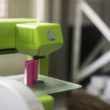 FDA today offered a clearer picture of how it plans to regulate the 3D printing of medical devices – including in non-traditional settings such as medical facilities and academic institutions.
FDA today offered a clearer picture of how it plans to regulate the 3D printing of medical devices – including in non-traditional settings such as medical facilities and academic institutions.
“In order to help ensure the safety and effectiveness of these products, we’re working to establish a regulatory framework for how we plan to apply existing laws and regulations that govern device manufacturing to non-traditional manufacturers like medical facilities and academic institutions that create 3D-printed personalized devices for specific patients they are treating,” FDA Commissioner Scott Gottlieb said in a statement.
Gottlieb also highlighted new guidance that clarifies what the FDA in the U.S. would like to see in submissions for 3D-printed medical devices. The guidance includes FDA regulators’ thinking on device design, testing of products for function and durability, and quality system requirements when it comes to 3D printing. FDA is describing the document as a “leapfrog guidance” because it offers initial thoughts on technologies emerging in the industry.
“Overall, it will help manufacturers bring their innovations to market more efficiently by providing a transparent process for future submissions and making sure our regulatory approach is properly tailored to the unique opportunities and challenges posed by this promising new technology,” Gottlieb said.
Highlights of the guidance document include:
- There’s suggested use of a production flow diagram and a high-level summary of each critical manufacturing process step. FDA says in the guidance document: “The effects of the different steps in the [additive manufacturing] processes can be seen in final device testing; however, determining the root cause of failures from manufacturing defects can be very difficult without a clear understanding of each step.”
- When it comes to overall device design, FDA recommends a comparison of the desired feature sizes of a final finished device to the minimum possible feature size of a 3D printing technique and the manufacturing tolerances of the individual machine. “This is to ensure that devices and components of the desired dimensional specifications can be reliably built using the chosen additive technology.”
- Patient-matched device design needs to take into account the effects of imaging used to create the proper fit, how modifications interact with design models, the complexity of design files, cybersecurity, and the handling of personally identifiable information.
- The document also lays out considerations when it comes to 3D printing software workflow, material controls and post-processing.
- FDA notes that quality may vary when an identical medical device or component is built using different additive manufacturing machines, even when using the same machine model, parameters, process steps and raw materials are used. “Therefore, knowledge of how the variability of each input parameter and processing step affects the final finished device or component is critical to ensuring part quality. Where the results of a process cannot be fully verified by subsequent inspection and testing, the process must be validated with a high degree of assurance and approved according to established procedures. In addition, all documentation must conform to the existing guidelines in the quality system regulation for device validation.”
- Changes to the device, manufacturing process or process deviations may trigger the need for a revalidation depending on potential risks. FDA encourages manufacturers to follow existing guidance.
- There’s also a description of the type of information FDA recommends in a premarket submission of a device made using additive manufacturing, including what FDA expects from a device description, mechanical testing, dimensional measurements, material characterization, removing manufacturing material residues, sterilization and biocompatibility.
Dr. Robroy MacIver – a congenital heart surgeon at Children’s Minnesota in Minneapolis who has pioneered using 3D printed models for surgery preparation – agreed that the reliability and safety of medical devices are of the utmost priority to the public.
“More capital needs to be invested developing integrated systems within the 3d printer that monitor the source code that designs the device, and the reliability of the output of the printer. Safety, therefore, will depend on adherence to a rigid process, rather than simply the end result,” MacIver said.
Gottlieb in his comments acknowledged that additive manufacturing allows non-traditional manufacturers to provide patient-matched devices, and FDA is working to provide a framework within existing legislation to ensure that the devices made at such non-traditional sites are both safe and effective, said Mary Beth Henderson, VP of regulatory affairs and quality systems at RCRI, based outside Minneapolis.
“Generally, these non-traditional manufacturing sites do not have quality systems in place that meet the requirements of Section 820 [of the Code of Federal Regulations],” Henderson said. “[Gottlieb’s] comments point to the balance that FDA must achieve between ensuring public safety, while at the same time encouraging innovation.”








